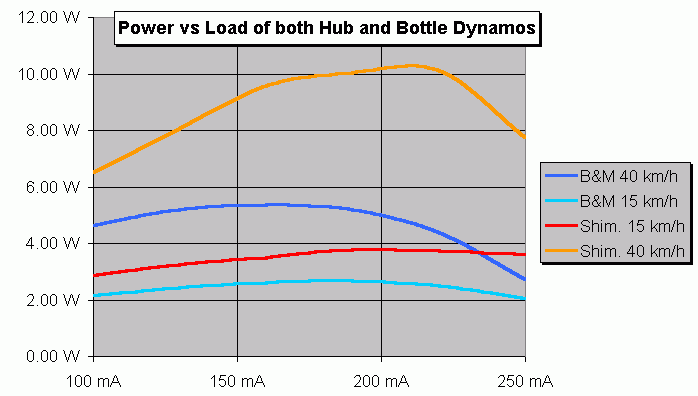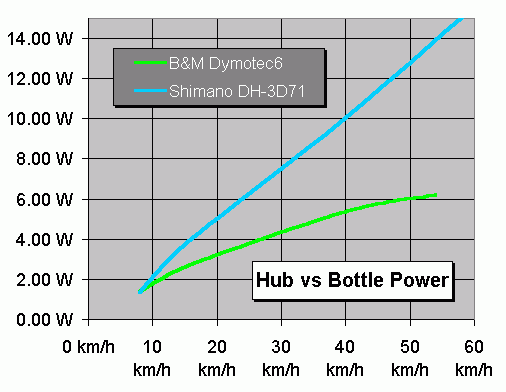Hub Dynamos
History
The hub dynamo, a dynamo integrated into the hub of the wheel, has long since been popular with riders who rely a lot on their generator. It used to be expensive, but it was reliable and virtually service-free. In recent years, more manufacturers offered hub dynamos, competition increased, prices dropped. Today, a very acceptable hub dynamo is no longer more expensive than a high quality bottle dynamo and it's quite common that touring bikes come with a stock hub dynamo.
As electric bicycles gain popularity, brushless hub motors are becoming common. While they are meant to be motors, they can also be put to work as generators. It's no surprise, given their construction is similar to hub dynamos. As weight and size of these motor suggest, they make quite powerful generators with the limit to the power output being more often the rider than the generator.
Electrical Characteristics
The hub dynamo is designed to the same specification as the bottle dynamo: It typically develops 6V across a 500mA load. Still there are some differences:
Hubs rotate at a much lower frequency than bottles, and though they have more poles to somewhat compensate, they still end up delivering a much lower frequency. At 15 km/h, the B&M Dymotec6 bottle dynamo (8 poles) outputs 168 Hz AC while the Shimano DH-3D71 hub dynamo (28 poles) outputs only 28 Hz at the same speed. At 8 km/h, a 28 pole hub is down to 15 Hz, which causes visible flicker of the light.
Apart from the frequency difference between hubs and bottles, there's something else: Hubs don't go into saturation easily so that at moderate to high speed, they develop a higher voltage than bottle dynamos, assuming they are not loaded with the typical 6 V / 3 W lights. To see whats possible, I ran a Shimano DH-3D71 at 136 km/h in a test stand. The voltage generated was sufficient to ignite a fluorescent tube and subsequently drive it at 55 V and 500 mA. This effect is very useful for building a high-powered LED light running off a hub dynamo.
While bottle dynamos are often equipped with limiting zener diodes across the output terminals, this is so far uncommon in hubs.
Test Setup
My initial test setup where the hub was belt-driven by a motor didn't work, due to the dynamo poles causing heavy vibration. I had to put the hub into a wheel and use a solid mount to eliminate its notchy behavior. The final hub dynamo test jig is a lot bigger than the one I built for bottle dynamos:

Measurements
Power vs Load Current of Hub and Bottle Dynamos
This measurement compares a Busch & Müller Dymotec6 and a Shimano DH-3D71.
Setup: Dynamo, voltage doubler (Greinacher type using 2x 1N5818 & 2x 1000uF), current sink (variable from 100 to 250 mA).

Observation: The hub delivers its maximum power at a slightly higher load current. It also delivers a higher power in general.
Power vs Speed of Hub and Bottle Dynamos
This measurement compares a Busch & Müller Dymotec6 and a Shimano DH-3D71. The Dymotec6 is loaded at 180 mA while the DH-3D71 is loaded at 190 mA. These are the currents where the dynamos deliver their maximum power.
Setup: Dynamo, voltage doubler (Greinacher type using 2x 1N5818 & 2x 1000uF), regulated current sink.

Observation: With perfect matching of the load, the hub dynamo delivers more power at higher speed and it doesn't suffer saturation.
Temperature Performance of Hub Dynamos
Due to their body size and metallic enclosure, hub dynamos have less of an issue with heat buildup. Still their output power drops somewhat as they run warm.
BACK to bottle dynamos
BACK to bicycle electronics overview



